Table of Contents
Perhaps the best known schemes for the classification of gold placer deposits are those by Jenkins and Brooks, the former being based on conditions of deposition and the latter on present position of the deposit. The field engineer should acquaint himself with these schemes, particularly that by Jenkins which has been developed in some detail. For the usual field investigation a somewhat simpler clarification will be found suitable. This list present all types of placer deposits:
- Residual placers.
- Eluvial placers.
- Stream placers.
- Bench placers.
- Flood gold deposits.
- Desert placers.
- Tertiary gravels.
- Miscellaneous types.
a) beach placers.
b) glacial deposits.
c) eolian placers.
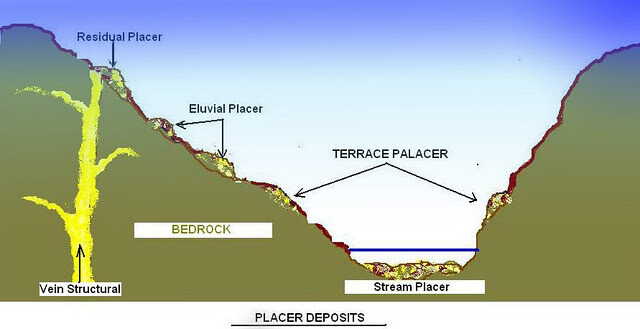
RESIDUAL GOLD PLACERS
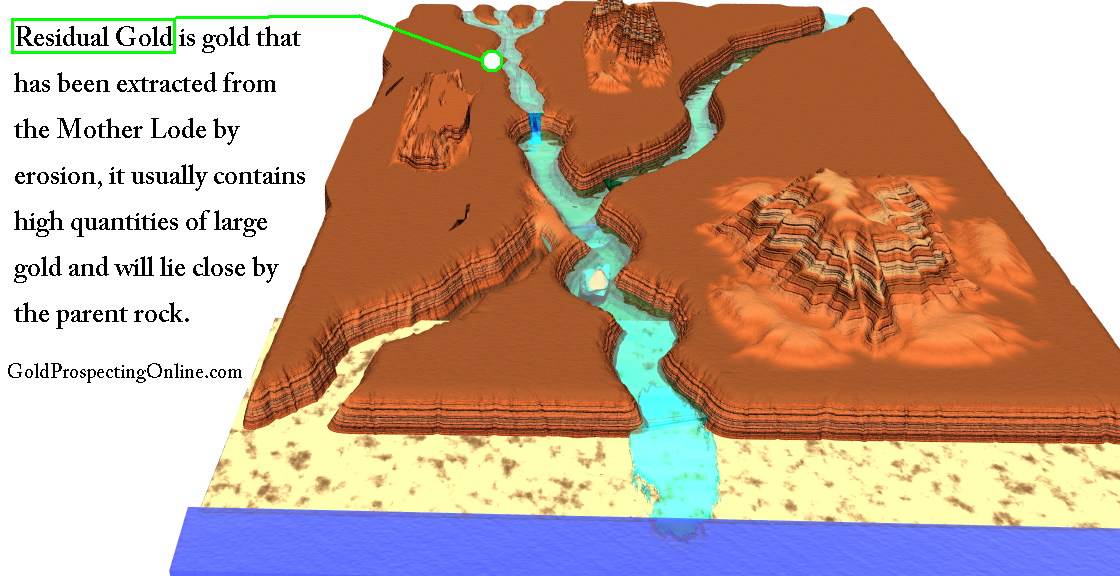
A residual placer is, in effect, a concentration of gold (or other heavy mineral) at or near its point of release from the parent rock. In this type of placer the enrichment results from the elimination of valueless material rather than from concentration of values brought in from an outside source. Residual placers may be rich but they are not likely to be large and as a class, they have been relatively unimportant. The “seam diggings” in El Dorado County, Calif., (Clark and Carlson, 1956, p. 435) offer an example of residual gold placers.
ELUVIAL GOLD PLACERS
Eluvial placers usually represent a transitional stage between a residual placer and a stream placer. Where one type merges into another, they cannot be clearly distinguished. They are characteristically found in the form of irregular sheets of surface detritus and soil mantling a hillside below a vein or other source of valuable mineral. It should be noted that the parent vein or lode may or may not outcrop at the actual ground surface. Eluvial placers differ from residual placers in that surface creep slowly moves the gold and weathered detritus down hill, allowing the lighter portions to be removed by rain wash and wind. As the detrital mass gravitates downhill, a rough stratification or concentration of values may develop but this is rarely perfected to the degree found in stream placers. Eluvial placers are typically limited in extent but there have been cases such as at Round Mountain, Nevada, (Vanderburg, 1936, pp. 133-145) where this type of placer supported large-scale mining operations using premium gold mining equipment.
STREAM GOLD PLACERS
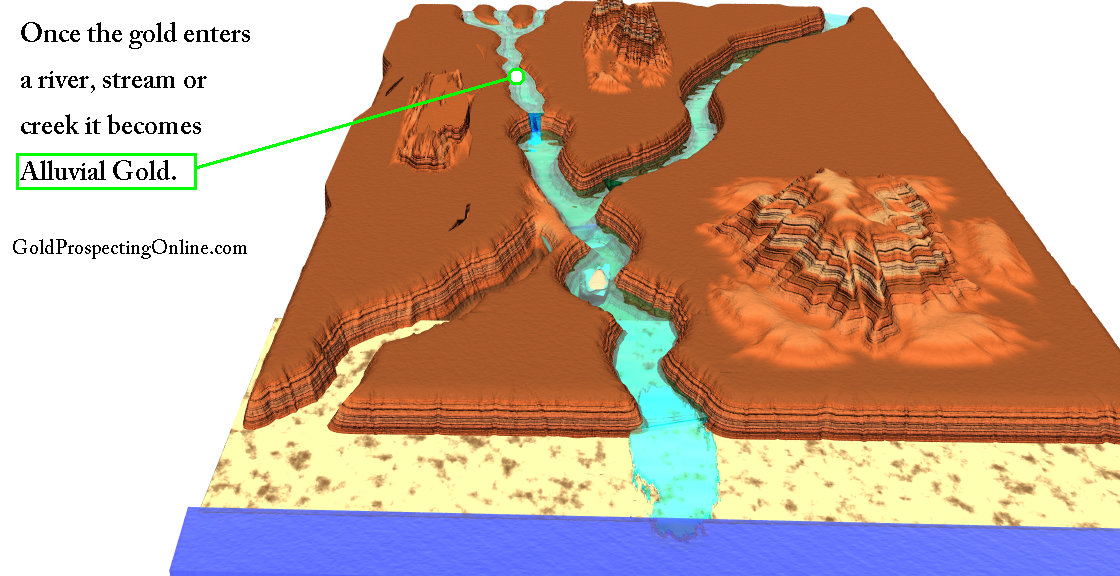
Stream placers are the most widespread type in the Western States and, accordingly, are the type most frequently encountered in mineral examinations. Individual deposits vary so much that few general statements can be made concerning them but for the purpose of this review, they can be conveniently divided into:
a. Gulch placers.
b. Creek placers.
c. River deposits.
d. Gravel-plain deposits.
a. Gulch placers:
Gulch placers are characteristically small in area, have steep gradients and are usually confined to minor drainages in which a permanent stream may or may not exist. This type of placer is, as a rule, made up of a mixture of poorly sorted gravel and detritus from adjacent hillsides. Because of steep gradient, the gravel accumulations are often thin and discontinuous. Boulders are commonly found in quantities that preclude all but simple hand mining operations. The gold is likely to be coarse and well-concentrated on bedrock. Gulch placers were usually the first to be found by the early miners and because most can be worked with simple hand tools, unworked remnants of shallow gulch deposits are not likely to contain material that would yield a profit today. The early-day miner was generally well-schooled by experience, and a dilligent worker. Any pay gravel that he left was usually cleaned up by the patient Chinese who followed. This was particularly true in gulch placers.
b. Creek placers:
In many districts creek placers have been important sources of gold but like the gulch placers most were carefully prospected by the early miners and worked out, where worthwhile to do so. Many of the lower-grade remnants left by the early hand miners have since been exploited by some form of mechanized mining, notably by dragline dredges during the depression years of the 1930’s. Creek placers as a group no longer contain significant economic reserves in the Western States but some in Alaska are mined with nonfloating washing plants and moveable sluices utilizing various combinations of hydraulic and mechanical excavation equipment.
c. River deposits:
River deposits are represented by the more extensive gravel flats in or adjacent to the beds of present-day rivers and as a class, they have been our most important source of placer minerals. They are generally similar to creek placers but the gold is usually finer, the gravel well-rounded and large boulders fewer or absent. Although the over-all deposit may be low-grade, pay streaks and bedrock concentrations capable of supporting dredging or other large-scale mining operations are not uncommon. At many places in California, the early miners diverted rivers through tunnels or bypassed the water in flumes to permit mining the river bed. In this manner, many miles of the middle and upper reaches of the principle gold-bearing rivers were effectively cleaned out. The lower reaches of many of these streams were systematically dredged and, at one time, where conditions were favorable, gravels returning five cents per cubic yard were dredged at a profit. Needless to say, few important river deposits remain unknown in the United States.
d. Gravel-plain deposits:
These are somewhat difficult to define as they may grade from river or bench deposits, into flood-plain or delta-type deposits and they can be geologically old, or recent. Gravel plains are found where a river canyon flattens and widens or, more often, where it enters a wide, low-gradient valley. The contained placers are generally similar to those in river deposits except for greater size and a more general distribution of gold. Because gravel-plain deposits are built by shifting stream channels, their gold is apt to have a wide lateral and vertical distribution and because of the relatively low velocities of streams flowing over flood plains, their placers are commonly made up of smaller-size gold compared with that found in the main stream deposits. Any larger gold carried by the main channel will likely be dropped close to the upper edge of the floodplain where the stream’s velocity decreases and its transporting ability is reduced. Although subject to surface wash and flood erosion, most gravel-plain deposits are relatively permanent. Examples of this type of deposit are the dredging fields at Hammonton, and those near Folsom, California.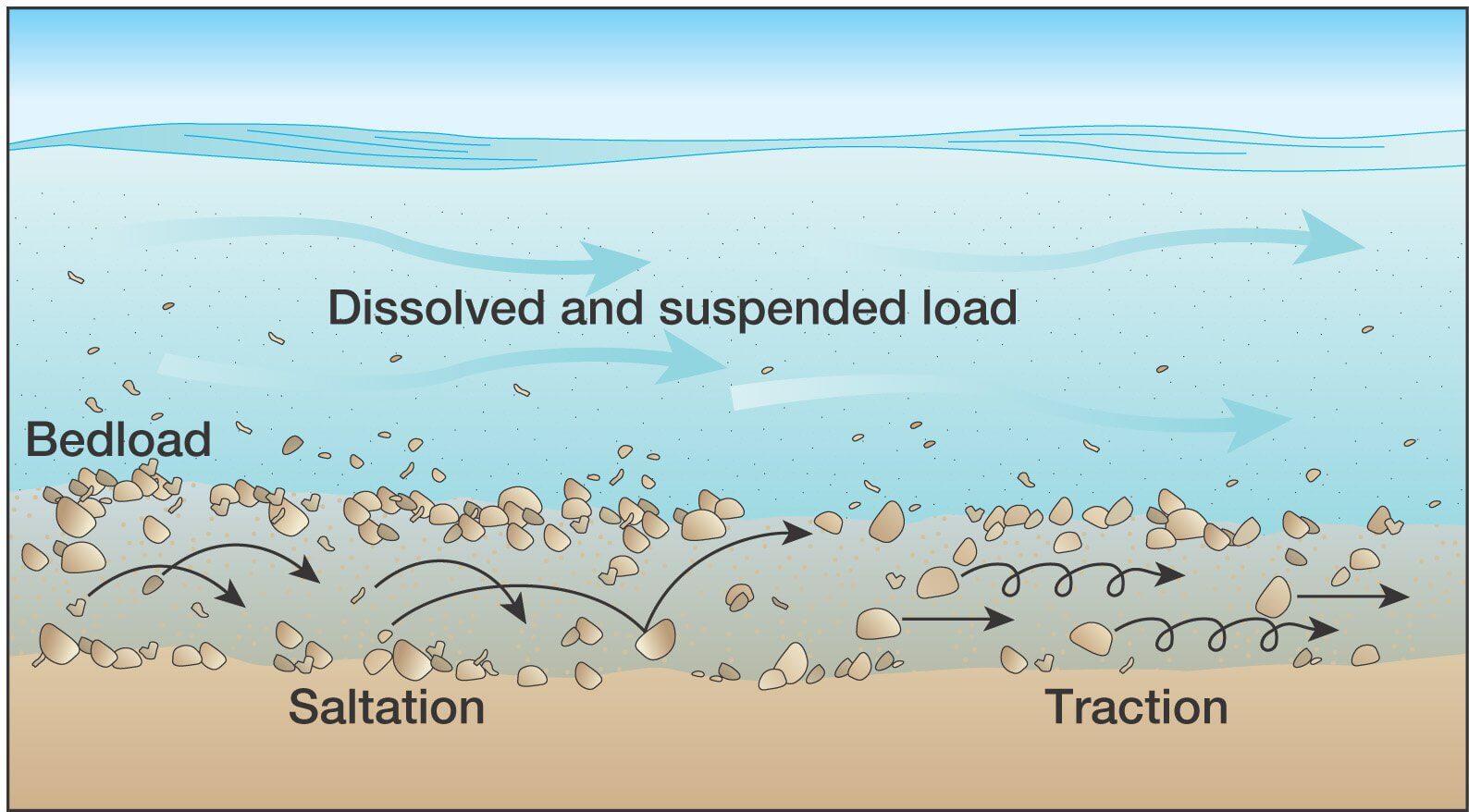
BENCH GOLD PLACERS
Bench placers are usually remnants of deposits formed during an earlier stage of stream development and left behind as the stream cuts downward. The abandoned segments, particularly those on the hillsides, are commonly referred to as “bench” gravels. Frequently there are two or more sets of benches in which case the miners refer to them as “high” benches and “low” benches. In California and elsewhere, most bench deposits were quickly found by the early miners who proceeded to work the richer bedrock streaks by primitive forms of underground mining. At the time these were referred to as “hill diggings.” Following the development of hydraulic mining in the 1850’s, many of the larger bench deposits were worked by hydraulicking and the smaller ones by ground sluicing. During the depression years of the 1930’s, much of the so-called “sniper” mining was carried out on remnants of bench gravels and it should be noted that these hard-working individuals seldom recovered more than 25 or 30 cents per day.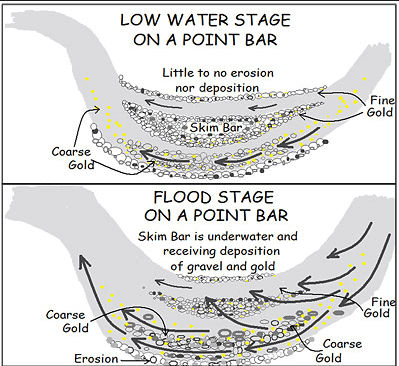
FLOOD GOLD DEPOSITS
As a rule, finely-divided gold travels long distances under flood conditions. This gold which can best be referred to by the miners’ term of “flood gold”, consists mostly of minute particles so small that it may take 1,000 to 5,000 colors to be worth 1 cent. With few exceptions such gold has proven economically unimportant. The mineral examiner should recognize the true nature of flood gold deposits so that he can guard against being misled by their seemingly-rich surface concentrations.
As a stream sweeps around a curve, the water is subject to tangential forces which cause a relative increase in velocity along the outer radius of the curve with a corresponding decrease along the inside radius. The bottom layer of water is retarded by friction and as a result, it has a tendency to flow sideways along the bottom toward the inner bank. This, in turn, causes sand and small gravel to accumulate in the form of an accretion bar along the inside bank of the curve and where flood-borne particles of gold are being carried down the stream, some will be deposited near the upper point of such bars, as shown in Figure 1.
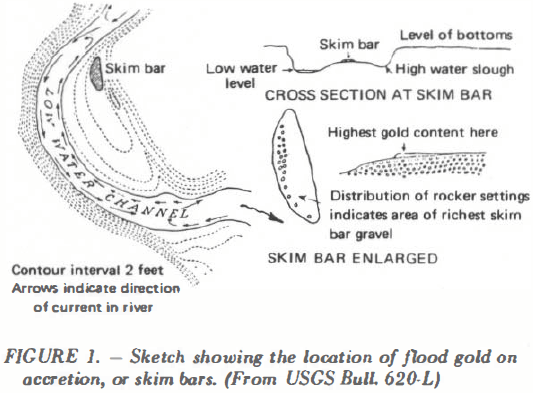
The foregoing is an oversimplification of a complex stream process but the fact is in streams draining a gold-bearing region, seemingly rich deposits of fine-size gold may be concentrated near the upper point of the inside bars, between the high and low water marks. Good surface showings of fine-size gold are not uncommon and although they may appear to be valuable, experience has shown that in most cases the gravel a few inches beneath these surface concentrations is nearly worthless.
In many gold-producing areas, particularly in parts of South America, river bars have been skimmed by natives year after year from time immemorial.
These are not permanently exhausted because floods deposit a new supply of gold and the renewal will continue indefinitely. These are called Charcas de Oro which literally translates “Gold Farms.”
The best-known flood gold occurrences in the United States are found along a 400-mile stretch of the Snake River in western Wyoming and southern Idaho. Here they are called “skim bars” (Hill, 1916) and have been intermittently worked since about 1860. See Figure 1. They were first exploited by transient miners employing rockers and simple sluicing operations and, by cleaning up the richer spots, a few did fairly well. It was inevitable that some would proceed to install dredges or other large washing plants and launch ambitious mining schemes on the strength of surface showings. Needless to say, following the exhaustion of superficial pay streaks, most of these large-scale mining schemes proved unprofitable. The foregoing is pointed out because flood gold concentrations are still to be found and without doubt, new mining ventures will be proposed and attempted from time to time, particularly by advocates of suction dredges. The mineral examiner should learn to recognize flood gold deposits and equally important, he should be fully aware of their pitfalls.
DESERT GOLD PLACERS
Desert placers in the Southwest occur under widely varying conditions but taken as a whole, they are so different from normal stream placers as to deserve a special classification. When dealing with the usual desert placer the mineral examiner must learn to disregard some of the rules of stream deposition, or at least, he must learn to apply them with caution. Desert placers are found in arid regions where erosion and transportation of debris depends largely on fast-rising streams that rush down gullies and dry washes following summer cloudbursts. During intervening periods, varying amounts of sand, gravel or side-hill detritus is carried in from the sides by lighter, intermittent rain wash which is sufficient to move material into the washes but not carry it further. When the next heavy rain comes, a torrential flow may sweep up all of the accumulated detrital fill, or only part of it, depending on intensity and duration of the storm and depth of fill. It should be obvious that the intermittent flows provide scant opportunity for effective sorting of the gravels or concentration of gold. Under such conditions the movement and concentration of placer gold will be extremely erratic. Moreover, where the entire bedload is not moved, any gold concentration resulting from a sudden water flow will be found at the bottom of the temporary channel existing at that time. This may be well above bedrock.
Desert miners have learned from experience that gold enrichments are sometimes found resting on caliche layers, particularly those near the ground surface, but such surface or near-surface concentrations are commonly small, residual-type accumulations of gold left behind where lighter material has been removed by rain wash and wind action. In other words, such enrichments result from the removal of valueless material rather than from the concentration of gold by normal stream processes. It should be stressed that in some desert placers the only economically minable ground is related to superficial concentrations and, at best, the chance of finding pay gravel is to a great extent fortuitous and largely dependent on careful prospecting.
Descriptions of many desert placer areas in the Southwest can be found in a number of publications among which are those published by the Arizona Bureau of Mines (Wilson and Fansett, 1961), the University of Nevada (Vanderburg, 1936) and the California Division of Mines (Haley, 1923, pp. 154-160).
TERTIARY GRAVELS DEPOSIT
Cold-bearing gravels of Tertiary age are abundant in the central Sierra Nevada region of California and to a lesser extent in northwestern California and southwestern Oregon. A few are found in northeastern Oregon and central Idaho. In California, many miles of these ancient river channels have been mined and according to figures offered by (Clark 1965, p. 44), seven of the California deposits have together produced gold amounting to more than 232 million dollars. The total production is not on record but it is known to far exceed this figure. Although few, if any, of the remaining Tertiary deposits can be mined at the present price of gold, the possibility of mining some at a future date is real and must be given serious consideration. Because of this future potential and today’s sporadic but continuing mining efforts, it is important that the mineral examiner have a clear concept of this special type of placer. The subject of Tertiary channels is too extensive for review here and, for this reason, the reader is directed to the following selected references: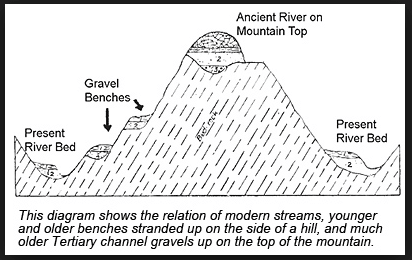
Tertiary Channels (Clark, 1965, pp. 39-44). This article contains a brief history of mining operations and descriptions of the Tertiary channels of the Sierra Nevada region. Contains indexed map with list of principal deposits and bibliography.
California’s Gold-Bearing Tertiary Channels (Jenkins & Wright, 1934). A condensed but excellent discussion of the origin of California’s Tertiary gravels and related geology. Highlights factors in gold accumulation and discusses methods of geologic exploration and proposed geophysical techniques as aids to future exploration work.
Tertiary Gravels of the Sierra Nevada of California (Lindgren, 1911). A classic on Tertiary gravels and related subjects. Most writers on placer subjects have drawn heavily from this source of information and as a result, quotations from and references to Lindgren’s work are prominent in the literature.
The Auriferous Gravels of the Sierra Nevada of California (Whitney, 1880). Discusses in considerable detail, the concepts (circa 1879) of origin and deposition of Tertiary gravels. The book is best suited to advanced study. Also contains maps and excellent descriptions of important Sierra Nevada placer mining districts and offers some of the best available data on individual mining operations of the day. Includes chapters by W.A. Goodyear and W.H. Pettee.
The Ancient River Beds of the Forest Hill Divide (Browne, 1890). One of many excellent articles describing Tertiary gravel deposits and related mining operations that have been published by the California State Mining Bureau.
Tertiary Gold-Bearing Channel Gravel in Northern Nevada County, California (Peterson and others, 1968). A report on studies of the San Juan Ridge Tertiary channel in Nevada County, California, made as part of the Department of the Interior’s Heavy Metals Program. It describes the geology and physical characteristics of a 15-mile section of this channel and also discusses geophysical investigations of the channel gravel carried out by personnel of the United States Geological Survey. Seismic, resistivity, gravity, magnetic, electromagnetic, and induced polarization geophysical methods were applied and evaluated. 22 pp., maps, illus.
Gold Resources in the Tertiary Gravels of California (Merwin, 1968). One of a series of reports presenting results of investigations conducted by the United States Bureau of Mines under the Department of the Interior’s Heavy Metals Program. It reviews the history of hydraulic and drift mining in California’s Tertiary gravels and the reasons for cessation of large-scale mining of these deposits. The report discusses general geology, the distribution of gold within the gravels, past production, and gold reserves. 14 pp., illus., bibliography.
Most of the foregoing references are of a technical nature and primarily of interest to engineers and geologists.
The term “Tertiary gravel” is used broadly to designate extensive gold-bearing gravel deposits laid down in ancient streams approximately 50 million years ago. These often-rich channels were subsequently buried under as much as 1500 feet of younger gravels and volcanic material which effectively sealed and preserved the original placers. The present Sierra Nevada range and its Tertiary deposits have since been elevated by mountain-building disturbances and, today, the dissected channels are typically found as lava-capped segments high above the present streams. Parts of the Tertiary deposits were worked extensively by the hydraulic method during the latter half of the 1800’s and in many places, the richer bedrock gravels were exploited by tunneling operations known as “drift mines”, some of which followed the ancient channels for miles along their subterranean course. Parts of California’s Tertiary channel system remain buried and unexplored; these are believed to contain a large gold reserve, available for mining at some future date.
GOLD PLACER DEPOSIT TYPES
There are other less publicized types of gold placers that are not economically important today, but which may achieve importance at some future date. For this reason a brief discussion and some selected references are offered here.
a. Beach placers:
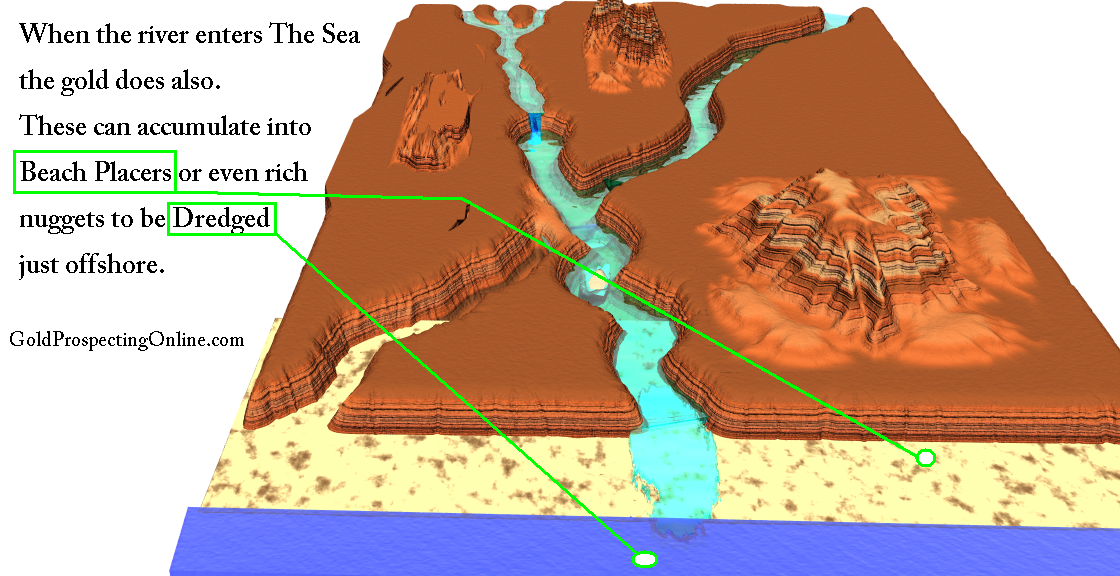
Beach placers may form where gold-bearing material is carried into the ocean by streams, or along the wave-cut base of a gold-bearing coastal plain. With exception of the highly productive beach placers discovered at the turn of the century at Nome, Alaska, none have been of great importance in the Western States. Typical beach placers along the Pacific coast are found as erratically distributed, somewhat lenticular concentrations or streaks of black sand minerals with varying amounts of finely-divided gold and in some places, with platinum-group minerals. Beach-placer black sands can be expected to consist largely of magnetite and ilmenite but significant amounts of chromite are found in some Oregon beach sands. In the case of gold-bearing beach placers, the individual black sand concentrations are seldom over 100 feet long or more than a few feet thick. Those found on the active beaches are the result of storm and tidal action, and they come and go with changing conditions of the beach. Some of the most productive placers have been found in ancient, elevated beaches that are now several miles inland.
Beach mining reached its height following discovery of the rich gold placers at Nome, Alaska, in 1898. Here, over two million dollars were produced from a 20-mile section of modern beach about 200 feet wide, and another 15 million from a series of inland elevated beaches. Subsequent discoveries on other Alaskan beaches, and elsewhere along the Pacific coast, resulted in other gold rushes but little production. Some beach placers along the California-Oregon coast have been worked in the past by simple hand mining methods and although a number of large-scale operations have been attempted, none, to this writer’s knowledge, have been successful. Placer deposits can be mined using a gold trommel.
Over the years a number of attempts have been made to mine magnetite-rich beach sands for their iron content and during World War II some chromite was recovered from ancient beach deposits in Oregon. (Kauffman and Baber, 1956, pp. 12, 13).
When investigating a beach placer, all reports and sampling data relating to the property should be examined critically. First it should be ascertained if the samples represent a minable volume, of if they actually represent selected or scattered streaks of enriched material. Second, it should be ascertained whether or not the reported gold values were determined by fire assay. In the absence of information to the contrary, it must be assumed that the reported values were obtained by fire assay. Little or no credence can be given sample results, or the reliability of a report, based on fire assay returns. There are persistent stories that beach deposits contain gold and platinum in forms not amenable to recovery by conventional processes, in fact, many of the larger-scale attempts to work beach deposits have been based on some kind of “revolutionary” or secret process intended to recover this elusive gold. The fact that few such schemes have gone into commercial production and none have become sustained operations is significant.
A number of excellent technical articles relating to beach deposits in Oregon, Alaska and California are available, among which are those by Pardee (1934); Dasher, Fraas and Gabriel (1942); Twenhofel (1943); Thompson (1915); Thomas and Berryhill (1962); and by Jenkins (1946). Recent work by the United States Geological Survey (Clifton, 1967) points out the problems normally encountered when sampling and analyzing beach or marine deposits containing detrital gold.
b. Glacial PLACER GOLD deposits:
The mineral examiner working in the Western States may seldom encounter a placer directly associated with glacial deposits but, on the other hand, it is not unusual for a miner to assert that a particular deposit, particularly if its origin is obscure, is a “glacier” placer. For this reason the engineer should know about glacial deposits as they relate to placers.
The fundamentals have been well set out by Blackwelder (1932) as follows:
“Since it is the habit of a glacier to scrape off loose debris and soil but not to sort it at all, ice is wholly ineffective as an agency of concentration for metals. Gold derived from the outcrops of small veins is thus mixed with large masses of barren earth. Attempts to mine gold in glacial moraines, where bits of rich but widely scattered float have been found, are for that reason foredoomed to failure.
“If a glacier advances down a valley which already contains gold-bearing river gravel, it is apt to gouge out the entire mass, mix it with much other debris and deposit it later as useless till. Under some circumstances, however, it merely slides over the gravel and buries it without distributing it.
“On the other hand, the streams born of glaciers or slowly consuming their moraines have the power to winnow the particles of rock and mineral matter according to size and heaviness. Such streams may form gold placer deposits in the well-known way by churning the load they carry and allowing the heavy minerals to sink to the bedrock. Placers may therefore be found in the deposits of glacial rivers if there are gold veins exposed in the glaciated area upstream. Nearly all the gravel which has been dredged for gold along the foothills of the Sierra Nevada was deposited by rivers derived in part from glaciers along the crest of the range, but most of the gold was probably picked up in the lower courses of such rivers. Since glacial rivers choke themselves and build up their channels progressively , their deposits are likely to be thicker and not so well concentrated as those of the more normal graded rivers which are not associated with glaciers.”
Where a glacier-related placer is encountered, the field engineer should, as an early step in his investigation, search out and study all available technical literature relating to the glacial history of the region. In particular, he should seek any reliable information on past mining of the deposit or similar deposits in the district, the object being to determine if significant gold concentrations are to be expected and, if so, under what conditions they are likely to be found.
Two districts having glacier-related placers that are well described in the technical literature , are those near Breckenridge and Fairplay, in Colorado. At Fairplay (Singewald, 1950), the actual moraines were mined locally but the most extensive and productive placers were found in outwash aprons extending away from the true moraines. At Breckenridge (Ransome, 1911, pp. 175-181), bench gravels associated with Pleistocene glacial deposits were mined by ground sluicing and hydraulicking while younger gravels derived from glacial moraines have been extensively dredged along the Swan and the Blue Rivers. Both districts are well described in the literature referred to.
In general, glacial debris that has been scoured from highly mineralized bedrock areas may be expected to contain gold but it will probably have little or no economic value unless resorted by post-glacial streams.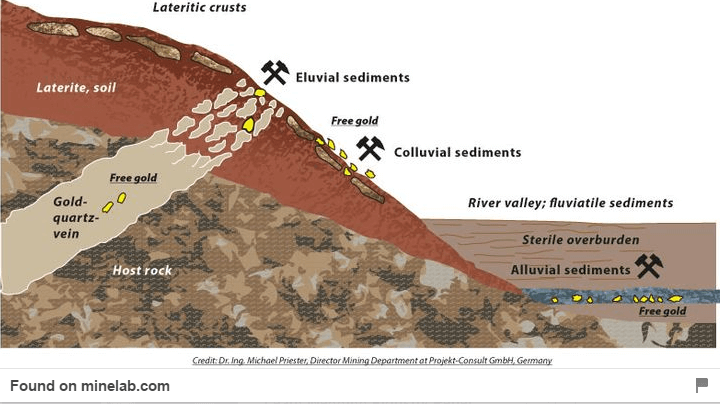
c. Eolian GOLD placers:
In desert regions the wind may act as an agent of concentration by blowing sand and the lighter rock particles away from a body of low-value material and leaving an enriched surface veneer containing gold or other heavy minerals in a somewhat concentrated slate. There have been many cases where wind-caused surface enrichments supported the activities of itinerant miners using hand tools and simple dry washers.
Although commercial-grade eolian placers are not likely to be encountered by today’s mineral examiner, he should be aware of their existence and should be alert to their misleading appearance. In other words, when taking near-surface samples from desert placers, he should guard against unintentional salting which could result from the inclusion of non-representative, wind-caused surface enrichments.
Types of Placer Deposits
There are two general types of placer deposits—residual placers and transported or alluvial placers. In both, the original source of the gold was in lodes, veinlets, stringers, or stockwerks in solid rock. In the residual deposits, which are relatively unimportant from the standpoint of gold production, the gold occurs in disintegrated rock at or near the original source, and concentration of the gold has been effected by removal in solution of soluble rock constituents and by mechanical washing out of lighter minerals.
Transported placers result from the removal of gold-bearing rock debris from its original situation by natural agencies (principally running water), the further disintegration of the rock during transportation with attendant liberation of the gold particles, and redeposition at some distance from the source. By reason of the sorting action of running water, gold, which is of much higher specific gravity than the rock-forming minerals, is separated from them and deposited, under favorable conditions, where the velocity of the water is reduced to a rate such that the gold is dropped but the lighter minerals are carried farther.
Brooks has classified placers largely on the basis of the present position of the deposits.
Classification of placer deposits (Brooks)
- Creek placers.—Gravel deposits in the beds and intermediate flood plains of small streams .
- Bench placers.—Gravel deposits in ancient stream channels and flood plains chat stand 50 to several hundred feet above the present streams. They represent the remnants of the stream beds during earlier stages of development.
- Hillside placers.—Gravel deposits intermediate between the creek and bench gravels; their bedrock is slightly above the creek bed and the surface topography shows no indication of benching.
- River-bar placers.—Placers on gravel flats in or adjacent to the beds of large streams.
- Gravel-plain placers.—Placers found in the gravels of the coastal or other lowland plains
- Sea-beach placers.—Placers reconcentrated from the coastal-plain gravels by the waves along the seashore.
- Ancient beach placers.—Deposits found on the coastal plain along a line of elevated benches.
- Lake-bed placers.—Placers accumulated in the beds of present or ancient lakes that were generally formed by landslides or glacial damming.
Another type of placer is the so-called dry placer occurring in arid regions in poorly assorted angular or subangular gravels over large areas of gulches, hillsides, mesas, and ridges instead of in well-defined channels.
Creek, bench, and river-bar placers have been the most productive. As gold is virtually the only metal recovered in large amounts by placer mining in this country, the following discussions and data apply to gold mining.
